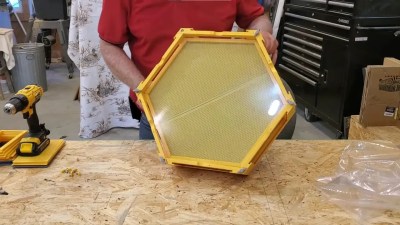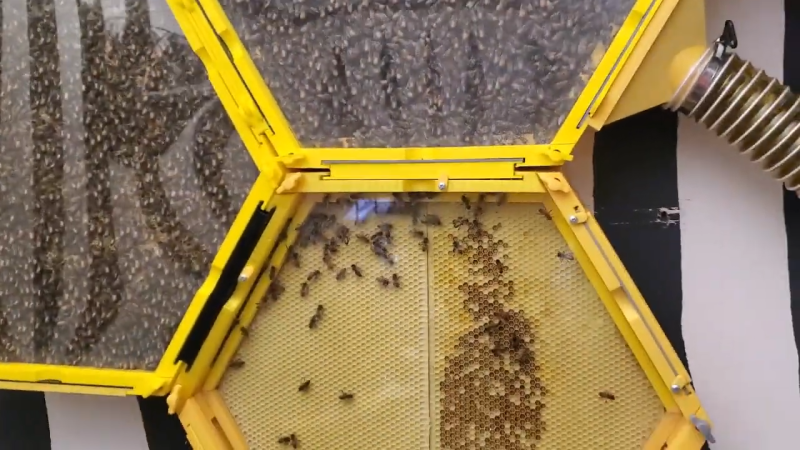Bees are incredible insects that live and die for their hive, producing rich honey in complicated hive structures. The problem is as the average beekeeper, you wouldn’t see much of these intricate structures without disturbing the hive. So why not 3D print an observation hive? With [Teddy Hatcher]’s 3D printing creativity, that is exactly what he did.

Hexagonal sections allow for viewing of entire panels of hexagonal cells, growing new workers, and storing the rich syrup we all enjoy. Each module has two cell panels, giving depth to the hive for heat/humidity gradients. The rear of a module has a plywood backing and an acrylic front for ample viewing. [Teddy] uses three modules plus a Flow Hive for a single colony, enough room for more bees than we here at Hackaday would ever consider letting in the front door.
As with many 3D printed projects involving food or animals, the question remains about health down the line. Plastic can bio-accumulate in hives, which is a valid concern for anyone wanting to add the honey to their morning coffee. On the other hand, the printed plastic is not what honey is added to, nor what the actual cell panels are made from. When considering the collected honey, this is collected from the connected Flow Hive rather than anything directly in contact with 3D printed plastic.
Beehives might not always need a fancy 3D printed enclosure; the standard wooden crates seem to work just fine for most, but there’s a time and place for some bio-ingenuity. Conditions in a hive might vary creating problems for your honey production, so you better check out this monitoring system dedicated to just that!
Thanks to [George Graves] for the tip!















On one hand this would be awesome, look really cool and the Flow Hive would make it easy to harvest some of the honey without ever opening things up.
On the other hand, I do worry about the long term health of the system/hive. I’ve heard some keepers talking bad about the Flow Hive too.
I guess bees are largely free roaming creatures if they don’t like their environment they are free to move on to another location. The flow frames seem to be a lot less distributive to the bees the hive doesn’t need to be opened to extract honey. The honey is drained from the bottom of the cell and the bees only need to uncap and refill.
Some bee keepers clip the wings of their queens to keep them grounded. Not a good idea IMO.
one thing that i can feel that will happen is people messing with their circadian rhythm. they produce and rely on melatonin and boy they probably aren’t adapted to electricity and its lumens
Good trick to put microplastics into honey.
Exactly this. Keeping the insects near low melting point plastic with all their VOCs and so on when the long term understanding of what that may do is limited seems like a bad idea.
Also, trees did not evolve with Perspex viewing ports for stickybeaking at the creatures, surely they prefer dark places.
Given the prevalence of plastics in the world keeping bee’s away from them large concentrations of them outside of the most rural of rural (as in so rural its not even actively farmed) environments seems pretty much impossible, I somewhat doubt having some around the hive they build matters that much (though this will be a good test case). Also pick the right plastics and it shouldn’t be a great health problem to the bee’s or up the food chain – not saying it is ever good for you, but there is a scale of not good for you and so many bad for you things you can’t really avoid – like the crap in the atmosphere, much of which is plastic.
That said nothing about this design but the tube to keep the hive indoors but let the bee’s out really screams that it needs to be anything but a wooden construction to me, so why take the chance the plastics will be a problem. If you really want to put the windows in make them glass, something we can be pretty darn sure the bee’s won’t be able to do anything with that also happens to be transparent.
I suspect you are both right and wrong on bee’s and electric lights these days – artificial lighting is so prevalent and has been for a great many bee generations that they are probably fairly able to deal with it. But actually inside their hives maybe not. Though given you probably only look at them a few times a week at most, and probably in daylight anyway – humans might be more flexible but they do tend to keep to normal day-night cycles. So I doubt it works out much different than regular hives having the frame lifted out to check the progress…
I mean most honey containers are made from HDPE or PET
It doesn’t mean it’s good for you. Or that bees should live in plastic. I feer thoughts like that are going in the wrong direction.
There’s a guy that uses large water bottles for a visible hive. He uses two bottles stacked on top of each other and the bees fill it from the top down (or bottom up, I forget). When one bottle is full he simply removes it and replaces it with an empty one so there is a continuous harvest of honey and the hive is never really disturbed because the bees are living in the bottle that isn’t touched.
He actually keeps one of his hives inside his house and the entrance is through a window which is super cool. He also uses this system outdors and details his insulation system to keep them alive through the winter. The insulation system doubles as camouflage because it’s illegal where he is.
It might have been featured on HAD before idk.
https://youtu.be/9ItlOFLTUAs?feature=shared
I don’t really get the concern about microplastics. I’m sure the amount this actually transfers into the honey is infinitesimal. I believe the vast majority of microplastics in food are worn off debris from the processing equipment.
Infinitesimal times alot is something…
Go to the grocery store and see what food you can buy that isn’t in plastic. (Spoiler: That aisle of tin cans, they have a plastic coating inside)
Technically infinitesimal times any real number is infinitesimal.
Might be ok in a shed, but to have this in your home? At some stage it’s going to need to be cleaned out which is going to create a horrible mess of sticky honey and very annoyed bees not to mention the requirement for copious quantities of smoke. Flow hives are only generally used by newbies who soon revert back to standard frames and boxes which are less destructive to the bees, more efficient and more reliable.
How is it less destructive to open the hive, smoke the bees and brush them away versus just opening the cells and letting the honey out?
You’re only opening the top of the hive where the honey is stored, not the main nest. No need to brush them off. Minimal smoke. Use a very nifty technology called ‘porta-esacpe’ . Google it. 0% bees harmed in the process.
Having a lower barrier of entry for people to start from is ok though, right? We can start with a glass bowl and pet store goldfish still and then maybe work our way up to a 200 gallon, saltwater tank with some coral and exotics if the interest strikes us? While flow hives might not be as preferred as standard frames/boxes used by apiarists, I don’t think it quite reaches the mark of ‘bee torture’.
Yeah, totally agree. Flowhives encourage new beekeepers because of the seemingly cool technology. Nothing wrong with that at all. Just that the tech itself aint that great. If they want to go more ‘pro’ then they’ll naturally graduate to the more traditional box and frame layout.
This must be rage bait, it’s beyond idiotic to bring religion to this place.
Epic troll sir. There will surely be a special place for you in the land of milk and honey.
Land of bovine gland ooze and bee barf!
I know very few people who eat bees.
I could be wrong, but did the bible not also forbid the eating of pigs? …… but i forget the reason why :(